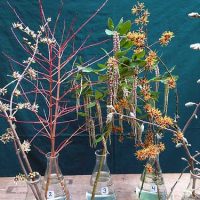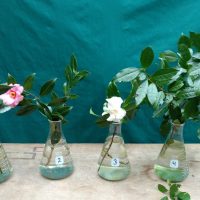“Pretty please, with a cherry on top!”

The following are five of the best flowering cherries suitable for growing in the Pacific Northwest. All have good resistance to brown rot blossom blight disease and are good choices size-wise for the home garden. All specimens below are currently in some stage of flowering along our historic Azalea Way Promenade.
1) Prunus x yedoensis ‘Akebono’ Daybreak Yoshino Cherry
‘Akebono’ (“Daybreak”) – This form has pinker flowers than the original Yoshino-type, and the petals are more frilled.
Read moreApril 2017 Plant Profile: Corylopsis pauciflora

Corylopsis pauciflora, the buttercup winter hazel, is one of the most charming plants in the witch hazel family. It features unique and colorful leaves, attractive and lightly fragrant flowers, fall color and is a good size for smaller gardens. It is the smallest and most compact growing member of the genus. The genus name means resembling (“opsis”) the leaf of a Corylus, or common hazel (though they are not related).
Selected Cuttings from the Washington Park Arboretum

1) Acer triflorum Three Flower Maple
A small, slow-growing deciduous 20’ to 45’ tree, where it is native to Manchuria and Korea. An excellent landscape tree boasting light-grey vertically furrowed bark and vivid red and orange fall color. The specific epithet makes reference to its flowers, which are borne in clusters of three.
This tree was discovered by noted plant explorer, Ernest H.
Spring Arrives at the Washington Park Arboretum

1) Cornus mas Cornelian Cherry
A native of Europe, C. mas has been cultivated for centuries in Britain. Flowers are produced in February and March on the leafless stems in short-stalked umbels from the joints of the previous year’s wood.
Oblong-ellipsoid, fleshy, bright red fruit are produced in late summer, and are edible when ripe.
Found throughout the Arboretum, these shrubs or small trees are easily identified at this time.
Spring in the Arboretum

The calendar says it’s spring, but what does Nature say? Discover the answer with a stroll through the Washington Park Arboretum.
Read moreSelected Cuttings from the Joseph A. Witt Winter Garden (Part II)

1) Corylopsis glabrescens Winter Hazel
This native of Korea and Japan teases us with flower buds that seem to be just on the edge of opening – for weeks!
The Joseph Witt Winter Garden contains multiple species of Corylopsis so that people may compare and appreciate the subtle differences in form and flower color the genus Corylopsis offers.
2) Pieris japonica Lily of the Valley Shrub
The spring flowers and often the new growth of Pieris can be quite showy, but the buds themselves decorate our gardens throughout the winter months.
Read moreSelected Cuttings from the Joseph A. Witt Winter Garden

The Witt Winter Garden was originally designed and planted in 1949. In the late 1980s the garden was named after Joseph A. Witt, an Arboretum curator who had a special interest in winter ornamental plants. Here is a small sampling of plants to be enjoyed now in the Winter Garden.
Download a map and plant list at:
https://botanicgardens.uw.edu/washington-park-arboretum/gardens/joseph-a-witt-winter-garden/
1) Chimonanthus praecox (Wintersweet)
The 15’ tall arching stems host beautiful and aromatic creamy, yellowish flowers.
Read moreFebruary 2017 Plant Profile: Hamamelis x intermedia ‘Jelena’

Hamamelis x intermedia ‘Jelena’ has long been one of the most popular of the hybrid witch hazels. Flowers appear as a bright copper-orange from a distance. Closer inspection reveals a bicolored flower, being reddish at the base but changing to more of an orange yellow at the tip. Although it has relatively little scent compared to the intoxicatingly fragrant Hamamelis mollis, it is prized for its flower color.
Read moreThe New Zealand Dead Look

New Zealand has a large number of shrubs with small tough leaves and wiry interlacing branches – divaricates. Some even have brown or grey new growth, giving a dead-like appearance. It is suggested that this may be a defensive mechanism to deter browsing moa (extinct flightless birds).
1) Coprosma propinqua (Mingimingi)
A visiting New Zealand scholar once described Coprosma as “a genus without morals that hybridizes incessantly” as she was politely telling us she didn’t think we were actually growing true Coprosma propinqua.
Read more